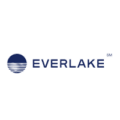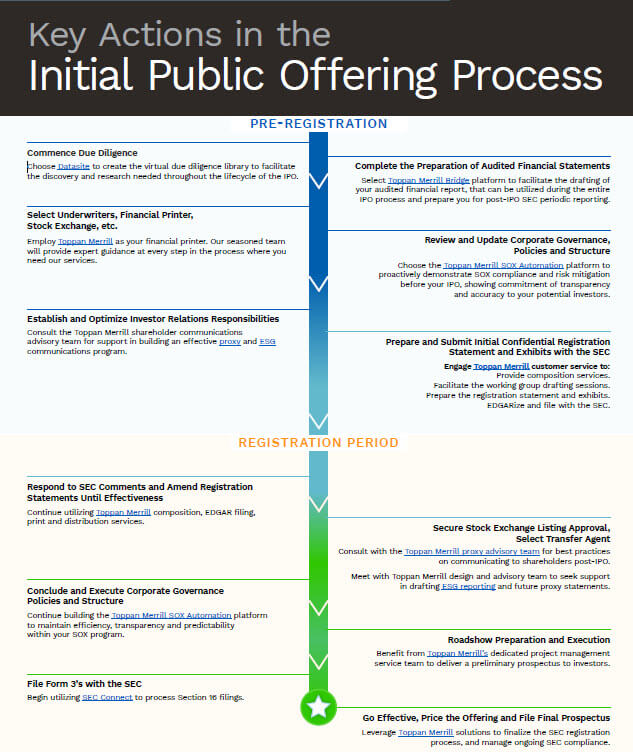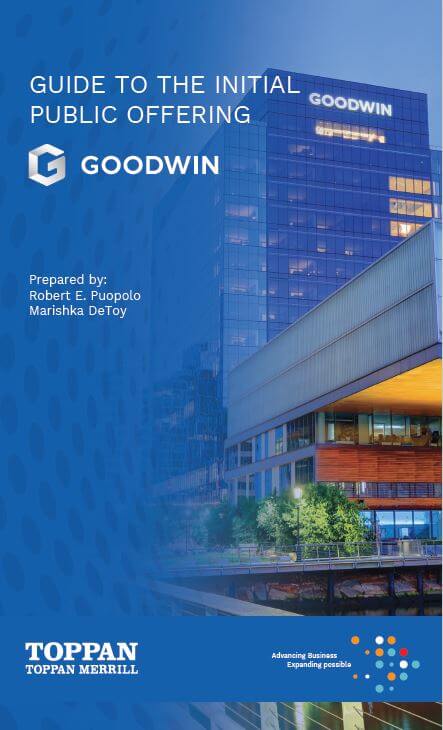Seize the opportunity – let us help you navigate the IPO regulatory disclosure process.
When you’re trying to complete an IPO on world capital markets, you either move at the speed of the markets or get left behind. It’s not just every second that counts – it’s every clause, every footnote, every decimal point and every deadline.
Empower your team to deliver more, more easily than ever before with support from a dedicated team of specialists, on-call 24/7.
You need a partner that has extensive IPO filing and industry expertise with demonstrated capital markets life cycle management experience. That partner is Toppan Merrill.
Tested and trusted by:

Offerings
Project Management
Benefit from dedicated project management service teams who provide around-the-clock coverage to create, maintain and expedite your time sensitive work.
Composition
The IPO process is exacting. Enjoy peace of mind knowing that your dedicated service team has decades of experience and multiple quality checks in place to ensure your prospectus is perfect.
EDGARization
With a well-seasoned team, you benefit from quick and accurate conversion of documents into acceptable SEC EDGAR format.
XBRL/iXBRL
Dedicated XBRL/iXBRL subject matter experts know exactly what it takes to stay ahead of regulatory disclosure requirements and keep you in compliance.
SEC Filing
With leading technology solutions and software backed by world-class service and subject-matter expertise, we execute complex IPO filings while navigating a world of ever-changing regulations.
SEDAR +
As an original adopter and tester of SEDAR, Toppan Merrill also specializes in Canadian Securities Administrators (CSA) submission standards and stays apprised of regulatory changes to ensure error-free filing.
Global Translations
Deliver, no matter the language, with Toppan Merrill translation capabilities in 14 languages.
Conference Facilities
Enjoy everything you need to work collaboratively, effectively and securely to get the deal done — global offices with state-of-the-art conference facilities and all the necessary amenities for your working group.
Printing and Distribution
End-to-end document creation including in-house printing and distribution, means you mitigate risk and ensure on-time delivery.

Why Toppan Merrill
Our team of qualified experts has an impressive average of 23 years of SEC-compliant document creation. Rest assured, with that tenure, we understand the intricacies of the Initial Public Offering (IPO) filing process. We have a complete understanding of each and every step to proactively guide and support your organization with best practices to optimize the entire process and ensure swift review and edit cycles so you can file against the toughest of deadlines.
Choose Toppan Merrill as your IPO filing agent for unmatched expertise and a proven process to guide your company through the intricacies of an SEC filing. Completing more than 62,000 SEC filings every year, we know the challenges and focus on providing comprehensive solutions that simplify the process and alleviate the burden on your organization.
Time is of the essence during the IPO process and we understand the importance of meeting deadlines while maintaining document integrity. Our service teams streamline the prospectus drafting process and the transmission of validated filings to the SEC. With data quality checks at each stage of document preparation, you can rely on us for both speed and accuracy from first draft to final printing and distribution.
Markets don’t wait and neither should you. Our dedicated IPO management service team is committed to providing exceptional, 24/7 support.
You’ll benefit from our proactive partnership, whether its ensuring SEC fees are correctly calculated and the account is funded or validating all of the necessary exhibits are included and correctly linked in the submission.
Even with 250+ SEC filings daily, our team boasts a 99.998% EDGAR filing accuracy rate.
As a global company, we are staffed in every theater with specialists who are familiar with the requirements of the capital markets regulatory bodies around the world. Whether you’re listing in the Americas, EMEA or APAC, you’ll enjoy this global network of experts delivering fast turnaround, accurate document creation and on-time delivery.
Honest, accurate, and transparent, with no surprise outcomes. Proud to support corporations and their law firms, accounting firms and other advisors to facilitate capital formation around the world.
Year after year, our customers rely on the expertise and service of Toppan Merrill.
Resources
Key Actions in the Initial Public Offering Process
A detailed infographic outlining the key actions in the pre-registration and registration process of an IPO.
Proven best practices: The complete IPO checklist
Having supported thousands of Initial Public Offerings, we asked our experts for best practices for a successful launch.
Guide to the Initial Public Offering
From making the key decision to go public, through the process to file with the SEC and then ongoing regulatory disclosure, this comprehensive guide takes you through every step.
Updates and Insights

How to choose the best SEC filing agent for an IPO

The complete IPO readiness checklist: Proven best practices

“Combination of a high level of technical expertise combined with excellent customer service made our filing process go smoothly.”Financial Technology Company – IPO – Carlos Graca, Senior Director of Operations
Contact our team to get started.
Phone
Have more questions?
Reduce complexity and get answers to some of our customers’ frequently asked questions.
See the full list of FAQsSEC Section 16 of The Securities Exchange Act of 1934 requires corporate insiders to publicly disclose their company affiliations, material changes in their holdings or unreported insider transactions through various regulatory filings with the SEC. Specifically, Section 16 mandates that Forms 3, 4 and 5 be filed by insiders—in other words, company investors who are directly or indirectly beneficial owners of more than 10% of stock in a company or directors and officers of the issuer of the securities. An insider of a first-time securities issuer or a new insider at an already-registered securities issuer must carry out the initial filing, Form 3. Form 4 is used to report material changes in insiders’ holdings. Form 5 reports any transactions that should have been included on a previous Form 4 or were eligible for deferred reporting such as gifts of shares or multiple small transactions. Section 16 reporting must be submitted electronically through the EDGAR computer system for the receipt, acceptance, review and dissemination of documents submitted in electronic format to the Commission. The SEC also requires companies to post the forms on their websites by the end of the next business day after filing them. Section 16 reporting deadlines were accelerated due to provisions of the SOX, the Sarbanes-Oxley Act of 2002. For support and additional information, explore our solutions here.
SEC Form S-1 is the initial registration required for a U.S. company. It must be filed before an IPO. Form S-1 is a registration statement under The Securities Act of 1933. A registration is mandatory before a security can be offered on public exchanges like the NYSE, NASDAQ, or AMEX.
Companies must provide information about their business model, intended use of capital, share price, and financials on Form S-1. A filing agent must provide a prospectus. This prospectus must include the offering price methodology. It must also include information on whether any dilution to other listed securities will occur.
The company must disclose any material business conducted between it, its directors, and external counsel. This is in addition to any other requirements. The submission is entered into the SEC’s EDGAR computer system. This system is used for the receipt, acceptance, review and dissemination of documents submitted electronically to the Commission. This process is similar to other forms.
Once filed, the Form S-1 becomes public record, enabling potential investors to conduct due diligence before shares become available. The JOBS Act, since April 2012, allows emerging growth companies to keep their Form S-1 confidential. This can be done up to 21 days prior to their IPO road show.
Form S-1/A is used for filing amendments to a previously filed Form S-1. Foreign companies may register with the SEC but their filing agent would use the SEC Form F-1 instead. For support and additional information, explore our Capital Markets Transactions solutions.
SEC Rule 144 regulates the resale of restricted securities. The Securities and Exchange Commission (SEC) outlines five conditions that need to be met in order for restricted securities to be resold. Another aspect of Rule 144 requirement by the SEC is that it regulates majority shareholders and their transactions of securities. The SEC does not allow any resales of restricted securities unless they are first notified of the sale and the holder is exempt from the registration process. For support and additional information, explore our Regulatory Disclosure solutions.
To raise funds for expansion, businesses often opt to raise capital through a securities offering. Many small companies offer equity in the form of common stock, while more established companies may also offer bonds representing their debt obligations. To offer equity or debt securities in the U.S., companies must either be registered with the SEC or exempt from registration in accordance with the federal Securities Act and state securities laws. Equity securities grant partial ownership interest to the purchaser, or stockholder. For equity offerings, a company files articles of incorporation specifying the amount and type of stock it plans to issue. To protect investors, state and federal regulations also require companies to disclose specific information to stockholders. Unless specifically exempt under the Securities Act, companies are required to file a registration statement with the SEC providing key information about the company, its securities and the offering. Once the SEC declares the registration statement effective, the company is allowed to make its IPO. When a company registers an offering with the SEC, it officially becomes a public company. Registration statements have two parts. The first is the prospectus, which is the legal offering made by a company issuing securities. The prospectus covers key facts about the issuer’s business operations, risks, daily operations and management in addition to audited financial statements. The issuer must deliver a prospectus to everyone who buys or offers to buy its securities. The second part of the registration statement includes confidential company information the issuer is not obliged to provide to investors, but must file with the SEC. Companies typically use the SEC Form S-1 to prepare the registration statement for a securities offering. Rules for regulation statement disclosures are outlined in Regulation S-K, and financial statements must be prepared for registration statements in compliance with Regulation S-X. Completed registration statements are filed using the SEC’s EDGAR computer system for the receipt, acceptance, review and dissemination of documents submitted in electronic format to the Commission. For support and additional information, explore our solutions here.
The Securities Exchange Act of 1934 created the U.S. Securities and Exchange Commission (SEC) and authorized it to govern the secondary market trading of company securities in the U.S. Secondary trading is the buying or selling of company securities (stock) typically through brokers or dealers. Often shortened to the Exchange Act of 1934 or the ‘34 Act, this landmark legislation laid the foundation for the financial regulation of public companies listed on stock markets including the New York Stock Exchange, American Stock Exchange and Pacific Stock Exchange.
President Franklin D. Roosevelt first signed the Securities Act of 1933 and the subsequent Securities Exchange Act of 1934 into law in the aftermath of the Stock Market Crash of 1929. The Securities Exchange Act of 1934 gives the SEC broad powers to enforce U.S. federal securities law, but also investigate potential violations such as insider trading, the sale of unregistered stocks, manipulation of market prices and disclosure of fraudulent financial information. The SEC’s consumer protection powers extend to the organizations and individuals participating in the securities markets which would include securities exchanges, brokers and dealers, investment advisors and investment funds. By law, and with SEC oversight, consumers and investors have access to public company registration statements, periodic reports among other securities forms through the EDGAR computer system for the receipt, acceptance, review and dissemination of documents submitted in electronic format to the SEC.
If a company has more than 500 shareholders and more than $10 million in assets, the Securities Exchange Act of 1934 requires that it file annual company information with the SEC using SEC Form 10-K as well as quarterly with SEC Form 10-Q. If a company experiences a material event such as a change in leadership or structure, the SEC mandates the filing of SEC Form 8-K to disclose these changes. Forms 10-K, 10-Q, and 8-K must be filed via the SEC’s EDGAR online system. These periodic reports and annual statements are examined by the SEC to ensure that they are compliant with disclosure requirements and that the American public and investors can make informed decisions about their investment decisions.
The Securities Exchange Act of 1934 also sets forth disclosure requirements in materials used to solicit shareholder votes in annual meetings held for approval of corporate action. The information is captured in proxy materials that must be filed with the SEC in advance of any solicitation. The SEC is charged with ensuring the company has provided all proper and accurate disclosures.
The Securities Exchange Act of 1934 requires disclosure of important information by anyone seeking to acquire more than 5 percent of a company’s securities by direct purchase or tender offer as such an offer could impact control of the public company.
The SEC is limited to seeking civil penalties such as fines and injunctions, barring a person from future roles such as a corporate officer. Depending on the severity or significance of the offense, the Department of Justice can file criminal charges for alleged violations of the Securities Exchange Act of 1934. The largest SEC fine to date was levied on JP Morgan Chase for the selling of mortgage securities by illegal means, leading to the 2012 financial crisis. For support and additional information, explore our SEC reporting solutions.













